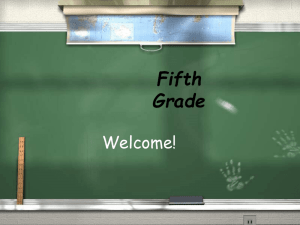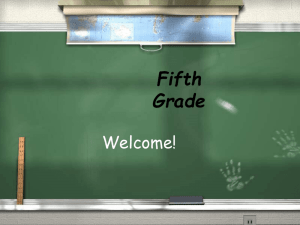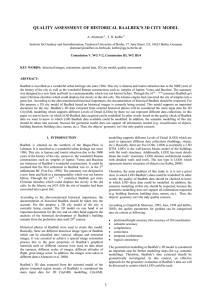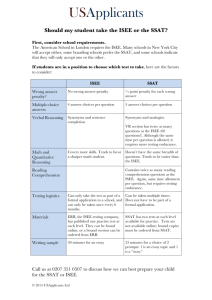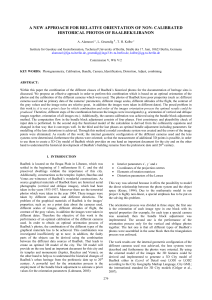RETRIEVING INFORMATION THROUGH NAVIGATING IN HISTORICAL BAALBEK
advertisement
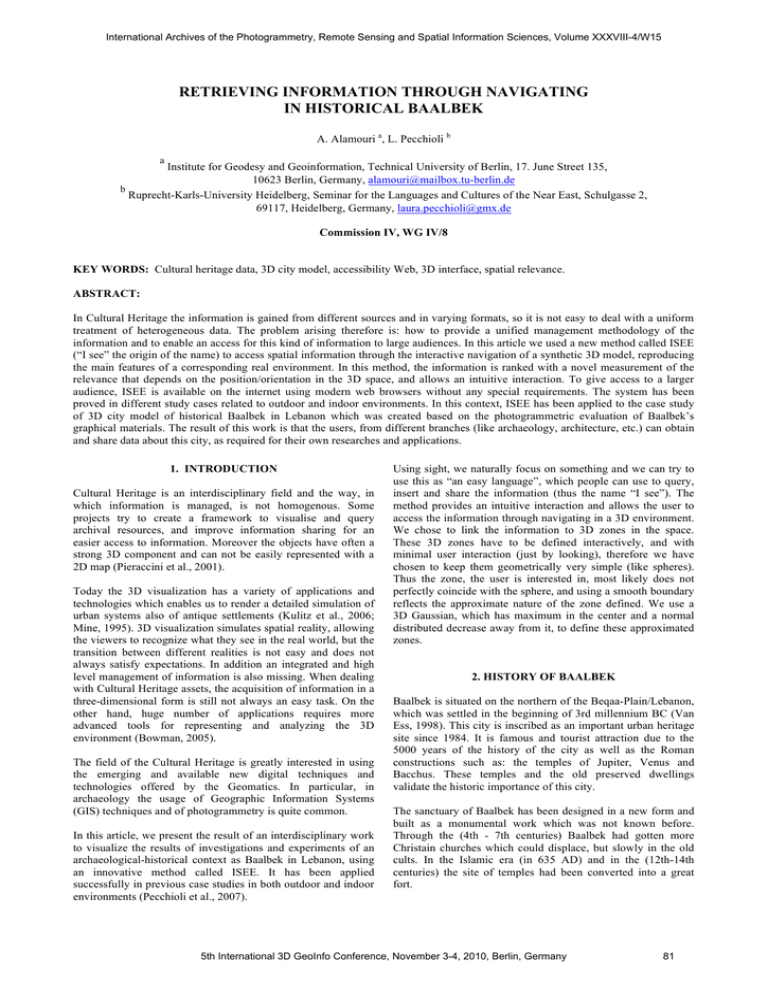
International Archives of the Photogrammetry, Remote Sensing and Spatial Information Sciences, Volume XXXVIII-4/W15 RETRIEVING INFORMATION THROUGH NAVIGATING IN HISTORICAL BAALBEK A. Alamouri a, L. Pecchioli b a Institute for Geodesy and Geoinformation, Technical University of Berlin, 17. June Street 135, 10623 Berlin, Germany, alamouri@mailbox.tu-berlin.de b Ruprecht-Karls-University Heidelberg, Seminar for the Languages and Cultures of the Near East, Schulgasse 2, 69117, Heidelberg, Germany, laura.pecchioli@gmx.de Commission IV, WG IV/8 KEY WORDS: Cultural heritage data, 3D city model, accessibility Web, 3D interface, spatial relevance. ABSTRACT: In Cultural Heritage the information is gained from different sources and in varying formats, so it is not easy to deal with a uniform treatment of heterogeneous data. The problem arising therefore is: how to provide a unified management methodology of the information and to enable an access for this kind of information to large audiences. In this article we used a new method called ISEE (“I see” the origin of the name) to access spatial information through the interactive navigation of a synthetic 3D model, reproducing the main features of a corresponding real environment. In this method, the information is ranked with a novel measurement of the relevance that depends on the position/orientation in the 3D space, and allows an intuitive interaction. To give access to a larger audience, ISEE is available on the internet using modern web browsers without any special requirements. The system has been proved in different study cases related to outdoor and indoor environments. In this context, ISEE has been applied to the case study of 3D city model of historical Baalbek in Lebanon which was created based on the photogrammetric evaluation of Baalbek’s graphical materials. The result of this work is that the users, from different branches (like archaeology, architecture, etc.) can obtain and share data about this city, as required for their own researches and applications. 1. INTRODUCTION Cultural Heritage is an interdisciplinary field and the way, in which information is managed, is not homogenous. Some projects try to create a framework to visualise and query archival resources, and improve information sharing for an easier access to information. Moreover the objects have often a strong 3D component and can not be easily represented with a 2D map (Pieraccini et al., 2001). Today the 3D visualization has a variety of applications and technologies which enables us to render a detailed simulation of urban systems also of antique settlements (Kulitz et al., 2006; Mine, 1995). 3D visualization simulates spatial reality, allowing the viewers to recognize what they see in the real world, but the transition between different realities is not easy and does not always satisfy expectations. In addition an integrated and high level management of information is also missing. When dealing with Cultural Heritage assets, the acquisition of information in a three-dimensional form is still not always an easy task. On the other hand, huge number of applications requires more advanced tools for representing and analyzing the 3D environment (Bowman, 2005). The field of the Cultural Heritage is greatly interested in using the emerging and available new digital techniques and technologies offered by the Geomatics. In particular, in archaeology the usage of Geographic Information Systems (GIS) techniques and of photogrammetry is quite common. In this article, we present the result of an interdisciplinary work to visualize the results of investigations and experiments of an archaeological-historical context as Baalbek in Lebanon, using an innovative method called ISEE. It has been applied successfully in previous case studies in both outdoor and indoor environments (Pecchioli et al., 2007). Using sight, we naturally focus on something and we can try to use this as “an easy language”, which people can use to query, insert and share the information (thus the name “I see”). The method provides an intuitive interaction and allows the user to access the information through navigating in a 3D environment. We chose to link the information to 3D zones in the space. These 3D zones have to be defined interactively, and with minimal user interaction (just by looking), therefore we have chosen to keep them geometrically very simple (like spheres). Thus the zone, the user is interested in, most likely does not perfectly coincide with the sphere, and using a smooth boundary reflects the approximate nature of the zone defined. We use a 3D Gaussian, which has maximum in the center and a normal distributed decrease away from it, to define these approximated zones. 2. HISTORY OF BAALBEK Baalbek is situated on the northern of the Beqaa-Plain/Lebanon, which was settled in the beginning of 3rd millennium BC (Van Ess, 1998). This city is inscribed as an important urban heritage site since 1984. It is famous and tourist attraction due to the 5000 years of the history of the city as well as the Roman constructions such as: the temples of Jupiter, Venus and Bacchus. These temples and the old preserved dwellings validate the historic importance of this city. The sanctuary of Baalbek has been designed in a new form and built as a monumental work which was not known before. Through the (4th - 7th centuries) Baalbek had gotten more Christain churches which could displace, but slowly in the old cults. In the Islamic era (in 635 AD) and in the (12th-14th centuries) the site of temples had been converted into a great fort. 5th International 3D GeoInfo Conference, November 3-4, 2010, Berlin, Germany 81 International Archives of the Photogrammetry, Remote Sensing and Spatial Information Sciences, Volume XXXVIII-4/W15 In the end, there are historical photos of Baalbek which are considered the main source about the historic data. These photos have different problems (due to their poor properties such as: different cameras used and different image scales, etc.). Thus, these problems are the main reasons that the data acquisition and accessibility based on the oriented model of the photos are not easy task. 3. BAALBEK’S 3D CITY GML-MODEL The modelling of 3D data extracted based on the oriented historical images of Baalbek is considered an important task, because it enables to represent Baalbek’s data as well as to document the historic city and its remains as it looked like. In the context of a city modelling, standards of CityGML (City Geography Markup Language) will be implemented. CityGML is defined as an open data model used for representation and exchange of virtual 3D city models. It is an international standard for the semantic and geometric representation of 3D city and landscape models (Kolbe, 2009). The modelling based on CityGML supports different four aspects of virtual 3D city model: semantic, geometry, topology and appearance. In this context, objects of reality can be represented in up to five well defined levels of detail (from LOD0 to LOD4) where the higher LOD the higher accuracy and structural complexity. Those 5 LODs were based on previous work related to different research groups on the usage of levels of detail in the 3D city modelling (Köninger & Bartel, 1998, Coors & Flick, 1998, Schilcher et. al., 1999). The coarsest level LOD0 is essentially a 2.5D DTM (Fig.1.a). In contrast, the LOD1 is the well-known blocks model of the buildings with flat roofs structures. In this LOD, the geometry of a building is represented a prismatic object with a flat top (cf. Fig.1.b). In other words: geometry of a building can be either represented with gml:SolidType as a volumetric object or the exterior surface of the interested building is represented with gml:MultiSurfaceType. Buildings are represented in LOD1 in a simple form i.e., extensions to buildings such as balconies need to be disregarded when creating of the LOD1 model. In addition, any curvatures in the geometry of walls and roof slab, these should be eliminated. To preserve such simplification of objects, different entities can be implemented such as: IFCWall entities (Industry Foundation Classes entities) or the usage of bounding box representation of elements (Kolbe, 2009, Isikdag & Zlatanova, 2009). On one hand LOD2 has more details about the roofs’ structures. In addition, exterior surfaces of a building can be represented in higher details (cf. Fig.1.c). The main differences between LOD1 and LOD2 - from geometrical aspect - are as following (Kolbe, 2009, Isikdag & Zlatanova, 2009): • • • classes of CityGML. These classes are aggregated under “_BoundarySurface” class and therefore can be used to explicitly differentiate Roof Surfaces, Wall Surface, Ground Surface and Closure Surface. LOD3 of CityGML includes openings associated with the outer façade of the building such as window and doors (Fig.1.d). Here, these openings are represented with Door and Window classes which are defined as sub-classes of the abstract class Opening. The class Window is used to represent the windows inside and the outer façade of the building. Similarly for the class Door, this is used to model the doors that are between the adjacent spaces and located at the outer façade of the building (Isikdag & Zlatanova, 2009). The last LOD of CityGML is LOD4 which represents interior structures of objects. The main classes of CityGML used to realize the interior structure of a building are Room and IntBuildingInstallation. The class Room presents the semantic object for modelling of the space inside the building. It should be closed (using for e.g. ClosureSurface) and can be represented (from geometrical view) by gml:Solid. In addition, semantic data related to the room can be preserved within the classes aggregated under _BoundarySurface class (Fig.1.e). Figure 1: The five levels of detail (LODs) defined by CityGML. LODs of CityGML (LOD0 to LOD4) are depicted in a, b, c, d and e, respectively (Source: IGG-Uni Bonn) In the case study of Baalbek, the 3D model of this city based on its historical images has been created (Alamouri & Gründig, 2009). The modelling of the available data is geometrically represented in two Levels of Detail (LOD1 and LOD2). Illustrations of both LODs are shown in the Figures (2.a & 2.b). In LOD2 outer walls of a building can be represented using multiple faces, but in LOD1 just only a single face for each wall. The curve geometry of elements can be represented within the model structure. Outer building installations such as chimneys, balconies, dormers, etc. can also modelled in the LOD2 of CityGML model. In this context, these installations can be represented within the BuildingInstallations class as gml:Geometry. On the other hand different parts of the outer façade of the building can be represented starting from LOD2 with different 82 Figure (2.a): Baalbek’s model in LOD1 (Source: Alamouri & Kolbe, 2009) 5th International 3D GeoInfo Conference, November 3-4, 2010, Berlin, Germany International Archives of the Photogrammetry, Remote Sensing and Spatial Information Sciences, Volume XXXVIII-4/W15 could think about using geometrically more detailed regions as information zones, and using the 3D Gaussian only for the view zone, but the 3D Gaussian function has a mathematical formula that simplifies the calculation of the overlap. Thus for the moment more detailed geometric information can be stored in the information, but is not used for the overlap (Figure 3). Figure (2.b): A part of Baalbek’s model in LOD2 (Source: Alamouri & Kolbe, 2009) The LOD1 model has been uploaded in ISEE web application to connect the information. We use to visualise and interactively navigate in 3D models on the web the Unity 3D technology (http://unity3d.com). Unity plug-in is a multiplatform game development tool and is available for all the major browsers (like: IE, Firefox and Safari, etc.) and platforms (Windows, OsX and Linux). 4. ACCESSING INFORMATION To access the historical information of Baalbek using the 3D models produced, we used the ISEE method. The idea of the method is based on the using of the simple action of “seeing”, as a mean to investigate and add information. The system can be used with the modern web browsers, allowing access to a wider audience without any special requirements. Figure 3: Contour plot of the overlap of two normalized Gaussians with width w1 and w2 and a distance r between the two centers. Darker color means a higher overlap, (Source: Pecchioli, 2008). The overlapping between the View Zone and the Information Zones defines this “spatial relevance of the information”. Intuitively, the relevance of information should be maximal when its Information Zone (IZ) coincides with the Viewed Zone (VZ), decreasing when they are far apart. New pieces of information can be inserted in the same way in which they are queried, just by looking in 3D model (Figure 4). The principle is that to find the relevant information using only the perspective of the user, what he/she is looking at. The information is associated with “approximated zones” of the space to represent better the objects of the real world. Our choice to use the 3D Gaussian function allows us to provide intuitive and efficient means of filtering information. We defined the approximated zones as the View Zone (VZ), the portion of the 3D model which is being looked at in the interactive 3D Viewer, and Information Zones (IZs), as the regions of 3D space associated with information. ISEE works with extended zones, not just points, and defines a spatial relevance, which depends on the spatial relationships (radius and distance) between the View Zone and the Information Zone. The center of the View Zone is defined as the point one hits shooting in the direction he/she is looking at, and the width is then calculated proportionally to the distance using the cone of view, so that its apparent size remains constant. The Information Zone is realised by associating information with a 3D Gaussian centred on a relevant point of the object to which we want to link the information, and with a width that should be comparable to the size of the object/detail the information refers to. By just looking at the object, that fills the field of view, the user can insert the information (the View Zone then should be roughly equal to the Information Zone). Thus, the symmetric treatment of VZs and IZs allows us to use the interactive 3D viewer to visually insert the IZ of a piece of information (authoring), or to “jump” immediately to the view related to some information (retrieval). It is important to note that the Gaussian is not used to define the exact information location, but rather an approximated zone which can be subsequently used to search and retrieve the information. One Figure 4: Third person view of VZ and IZ from behind. The VZ is represented as a green sphere, the IZ as red spheres, and the view cone is gray. The ISEE method can be seen in some way as a method to select the most relevant zone for the actual view. The most common technique used in 3D space is the selection method like Ray casting, but it works with points or discrete objects and does not cope well with overlapping objects. This uses a ray that is shooting and the selected object is the one hit by it. This has several drawbacks: it allows selecting only objects in the foreground, not hidden, and it is very sensitive on angular errors for distant objects. In this method, the spatial ranking (achieved calculating the overlap of these normalized regions) mirrors the intuitive expectations: if a user is concentrating on a detail, the related information will have a more significant meaning (a higher rank) than the whole object, whereas if he/she is looking at the whole object, it will result in the opposite behaviour. This ranking method has several advantages over previously used methods, especially with high densities of data and partially overlapping regions. As it uses the size of regions to filter the information, it has a better performance than purely distance 5th International 3D GeoInfo Conference, November 3-4, 2010, Berlin, Germany 83 International Archives of the Photogrammetry, Remote Sensing and Spatial Information Sciences, Volume XXXVIII-4/W15 based methods. Moreover, a user can interactively refine his search either by carefully focusing on the parts of the model he is looking at, or by more traditional means using keywords based filtering (Pecchioli, 2008). 5. BAALBEK WEB APPLICATION We think that the interactive visualization makes information more accessible and improves user experience. The idea of using the simple action of “seeing” can represent an easy instrument for the users to access the information of the context of Baalbek. Thus, we developed a web application using ISEE, where the user can: • • • • • • • • visualize and navigate in the model in LOD1 visualize the results extracted from the oriented images of the historical Baalbek (Alamouri & Gründig, 2009) access the information in its context access to many data and in different formats (UTF-8, HTML, XML, KML, JPEG/PNG, TIFF, etc.) read in a detail window the meta-information use one or more Filter Keys for a local search share of data by sending the URL archive the information in simple format for a future accessibility. ISEE is based on an application written with the web framework Ruby on Rails (http://rubyonrails.org/), which using a relational database (MySQL) and a file based archive. This allows one to perform searches on the data efficiently (Pecchioli, 2010). In particular, the main menu of Baalbek web gives access to following topics: location of the city temples of Baalbek archaeological - historical information Baalbek models in LOD1 and in LOD2 In the web application only in the LOD1 model is interactive (Figure 5). The LOD2 model has been visualized using another viewer called Aristoteles , which cannot be used in the browser. Therefore the user can also access a movie of the LOD2. 6. CONCLUSION We have shown how one can able to access and manage the available spatial data of historical Baalbek through the userfriendly interface of a new method called ISEE. This method is based on the simple action of navigating in a 3D environment to retrieve the relevant information. ISEE is suitable using the modern web browsers to all categories of users and doesn't require any special requirements. In the case as the context of Baalbek, where the data accessibility is difficult, it can contribute to the information dissemination. Moreover the intuitive interaction keeps the information in its context navigating in the model and this enriches the experience user. At the moment the interface is changing and the new interface of the system will be announced soon. The main homepage of ISEE is in built: http://isee.kitabi.eu/. 7. REFERENCES Alamouri, A., Kolbe, T. H., 2009. Quality assessment of historical Baalbek's 3D city model. In: Proceedings for ISPRS WG II/2+3+4 and Cost Workshop on Quality, Scale & Analysis Aspects of Urban City Models, Lund, Sweden, ISPRS XXXVIII-2/W11. Alamouri, A., Gründig, L., 2009. 3D reconstruction of historical Baalbek based on historical vertical, oblique and terrestrial images. In: The Proceeding of the 22nd CIPA symposium, Kyoto, Japan. Bowman, D. A., Krujff, E., La Viola, J. J., Poupyrev, I., 2005. 3D User Interfaces, Theory and Practice. Addison-Wesly, USA. Coors, V., Flick, S., 1998. Integrating Levels of Detail in a Web-based 3D-GIS. Proc. of ACM GIS'98 in Washington D.C., USA, ACM Press. Isikdag, U., Zlatanova, S., 2009. Towards Defining a Framework for Automatic Generation of Buildings in CityGML Using Building Information Models. 3D Geo-Information Sciences. J. Lee, Zlatanova, S. Seoul, Korea, Springer: Chapter 6, pp. 79-96. ∗ Kolbe, T. H., 2009. Representing and Exchanging 3D City Models with CityGML. In: 3D Geo-Information Sciences. Springer, Seoul, Korea. Chapter 2, pp. 15-31. Köninger, A., Bartel, S., 1998. 3D-GIS for Urban Purposes. Geoinformatica, 2(1). Kulitz, I., Ferschin, P., Matejowsky, P., 2006. 4D Visualization Methods in Archaeology. In: Proceedings Archäologie and Computer, Kulturelles Erbe und Neue Technologien, Workshop 11, Wien, Austria. Mine, M. R., 1995. ISAAC: A virtual environment tool for the interactive construction of virtual worlds. Technical Report TR95-020, Chapel Hill, NC, USA. Figure 5: The navigation window for LOD1 model ∗ Aristoteles viewer project is developed for different applications that need to develop or evaluate new features and attributes for 3D models. (Source: http://www.ikg.uni-bonn.de/aristoteles/index.php/Aristoteles). 84 Pecchioli, L., Mohamed, F., Carrozzino, M., Leitner, H., 2007. Accessing Information Through A 3D Interactive Environment. In: International Cultural Heritage Informatics Meeting (ICHIM07). J. Trant and D. Bearman (eds) Toronto: Archives & Museum Informatics. 5th International 3D GeoInfo Conference, November 3-4, 2010, Berlin, Germany International Archives of the Photogrammetry, Remote Sensing and Spatial Information Sciences, Volume XXXVIII-4/W15 Pecchioli, L., 2008. Accessing Information navigating in a 3D interactive environment, European Doctorate in Technology and Management of Cultural Heritage, XX Cycle, IMT Institute for Advanced Studies, Lucca (Italy). Pecchioli, L., 2010. ISEE: advanced open e-learning authoring environments, Electronic Imaging & the Visual Arts - EVA 2010 Florence, Italy, V. Cappellini Pitagora Editrice Bologna (eds), pp.96-101. Pieraccini, M., Guidi, G., Atzeni, C., 2001. 3D digitizing of cultural heritage, Journal of Cultural Heritage, Vol. 2, Issue 1, January-March, pp. 63-70. Schilcher, M., Guo, Z., Klaus, M., Roschlaub, R., 1999. "Aufbau von 3D Stadtmodellen auf der Basis von 2D-GIS." Zeitschrift für Photogrammetrie und Fernerkundung (ZPF) Vol. 67, No. 3. Van Ess, M., 1998. Heliopolis- B4aalbek, Forschen in Ruinen 1898-1998. 5th International 3D GeoInfo Conference, November 3-4, 2010, Berlin, Germany 85
